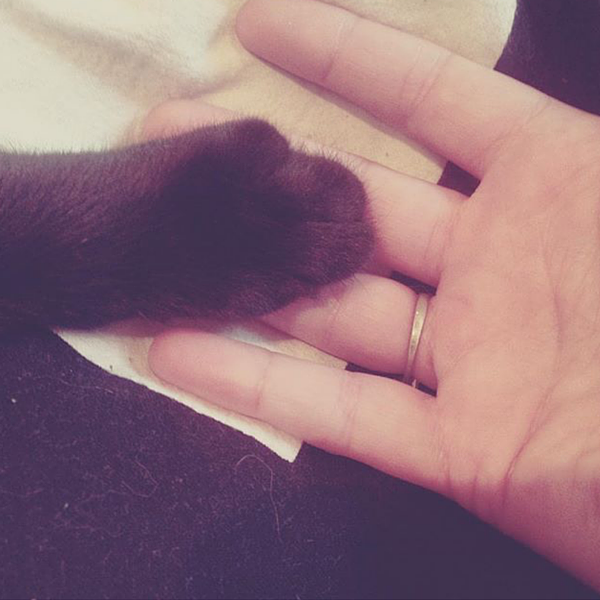
Tips & Tools
Managing your anxiety
The Paw-sitive Effects of Pet Therapy


by Taylor Waines
Animals have played a crucial role in the lives of humans for many years. Dogs and other animals have lent a paw to the blind, police, and security. However, for around 200 years, they have also helped to improve patients social, emotional, physical and cognitive functioning.
Late into the 1800’s Florence Nightingale, a recognized founder of modern nursing, noticed the impact animals had on human’s health. Nightingale found that small pets helped to reduce anxiety in both children and adults living in psychiatric institutions, and wrote about it in her book Notes on Nursing.
In the 1930’s, Sigmund Freud began using animal-assisted therapy (AAT) in his psychotherapy lessons. In one case, he noted that when his dog was close to the patient, they felt a relief of tension. If the dog was on the other side of the room though, the patient began to feel tenser. Throughout his trials he found patients were more comfortable talking when the dog was around than when he wasn’t. From here, he began using the dog as a way to relieve tension and allow patients to open up freely.
 Animals have also helped non-verbal patients to speak. In the case of a 9-year-old non-verbal boy, child psychotherapist Boris Levinson saw a complete transformation after using a dog during his sessions. When Levinson’s dog Jingles sat by the boy, he would begin to communicate during his sessions. After observing similar results with other patients, Levinson brought forward his findings, which were not credited for some time. Levinson became known as “the father of AAT,” and wrote a book called Pet-Oriented Child Psychology.
Animals have also helped non-verbal patients to speak. In the case of a 9-year-old non-verbal boy, child psychotherapist Boris Levinson saw a complete transformation after using a dog during his sessions. When Levinson’s dog Jingles sat by the boy, he would begin to communicate during his sessions. After observing similar results with other patients, Levinson brought forward his findings, which were not credited for some time. Levinson became known as “the father of AAT,” and wrote a book called Pet-Oriented Child Psychology.
Soon after, AAT began to grow, and by 1989 Delta Society created a certification program to provide animals with efficient training for therapeutic uses. AAT is now offered in many healthcare facilities, hospitals, nursing homes and even rehabilitation centres.
Human-animal interaction has been known to provide many benefits on a wide-variety of patients.
These include:
- Improvement in social attention, behavior and interpersonal interaction
- Increase in mood
- Lowers cortisol, heart rate, and blood pressure
- Reduction of self-reported anxiety and fear
- Improvement of mental and physical health, specifically cardiovascular
In a study called Effect of Service Dogs on Dalivary Cortisol Secretion in Autistic Children, researchers found a significant decrease in cortisol awakening response (CAR) levels. In a trial of 42 children with autism, researchers measured CAR levels before the introduction of service animals at 58 per cent. Following the introduction of the animals, the CAR decreased to 10 per cent while the animals were present. Once the animals were removed CAR increased significantly to 48 per cent. The psychological impact of service dogs on children with autism sheds light on the potential benefits of implementing service dogs in the lives of those children. This also shows the possibility of reducing CAR with service animals in other patients.
Researchers at Georgia State University, Idaho State University, and Savannah College of Art and Design, provided animal-assisted therapy to 55 students at a small arts college. The students were allowed to pet, brush, play fetch, sit near, draw, and photograph the dogs for up to two hours. Researchers found a decrease in self-reported anxiety and loneliness of 60 per cent. Of the participants, 84 per cent said their interaction with the dog was the most noteworthy part of the program.
 Though dogs are more commonly used for AAT, cats provide many benefits for humans as well. Researcher Elizabeth von Muggenthaler, a specialist in the field of bioacoustics at the Fauna Communications Research Institute in North Carolina (FCRI), found that a cat’s purr does more than we think. Bioacoustics studies the sound made by and affecting living organisms in relation to their behavior, especially in communication. In von Muggenthaler’s research, she recorded and measured the purrs of 44 felids, including pumas, domestic cats, cheetahs and ocelots. This gave her a general range of the purrs in different types of cats. Although they range from 20 to 140 Hz, the average range for domestic cats is between 25 and 50 Hz. Remarkably, evidence shows that being exposed to frequencies of 20 to 50 Hz increases bone density, alleviates pain and heals tendons and muscles.
Though dogs are more commonly used for AAT, cats provide many benefits for humans as well. Researcher Elizabeth von Muggenthaler, a specialist in the field of bioacoustics at the Fauna Communications Research Institute in North Carolina (FCRI), found that a cat’s purr does more than we think. Bioacoustics studies the sound made by and affecting living organisms in relation to their behavior, especially in communication. In von Muggenthaler’s research, she recorded and measured the purrs of 44 felids, including pumas, domestic cats, cheetahs and ocelots. This gave her a general range of the purrs in different types of cats. Although they range from 20 to 140 Hz, the average range for domestic cats is between 25 and 50 Hz. Remarkably, evidence shows that being exposed to frequencies of 20 to 50 Hz increases bone density, alleviates pain and heals tendons and muscles.
This healing does not just allow cats to live longer, but may also aid human health. If you are stressed, sore, or have a migraine, cuddling with your purring cat can help to alleviate symptoms and promote better health through vibration therapy.
The presence of an animal during therapy has been found to alleviate symptoms of anxiety, loneliness and depression. Whether it is the distraction from the present situation, the comfort of not being alone, or the healing properties felines share, many patients have and continue to benefit from AAT.
Works Cited
"Animal Therapy Reduces Anxiety, Loneliness Symptoms in College Students." - Georgia State University News. N.p., n.d. Web. 19 May 2016.
"Animal-Assisted Therapy: An Exploration of Its History, Healing Benefits, and How Skilled Nursing Facilities Can Set Up Programs." Annals of Long Term Care. N.p., n.d. Web. 19 May 2016. Beetz, Andrea, Kerstin Uvnäs-Moberg, Henri Julius, and Kurt Kotrschal.
"Psychosocial and Psychophysiological Effects of Human-Animal Interactions: The Possible Role of Oxytocin." Frontiers in Psychology. Frontiers Research Foundation, n.d. Web. 19 May 2016.
Effect of service dogs on salivary cortisol secretion in autistic children. Viau, Robert et al. Psychoneuroendocrinology, Volume 35, Issue 8, 1187 – 1193
"The Effects of Animal-Assisted Therapy on Anxiety Ratings of Hospitalized Psychiatric Patients." Psychiatric Services. N.p., n.d. Web. 19 May 2016.
"How Your Cats Purrs Can Actually Heal You - CRIME BUZZ." CRIME BUZZ. N.p., 19 Mar. 2016. Web. 19 May 2016.

Taylor Waines is a graduate of Durham College's Web and Print Journalism program. She has written many articles for DC's paper The Chronicle, on topics such as health, mental health and well-being. She interned at the Cam's Kids Foundation as part of her program to share her knowledge and research on mental health.
- All
-
29 Nutrition
Nutrition
- 73 Mindfulness and Relaxation
- 27 Student Life
- 8 Exercise
- 51 Treatments & Therapies
- Anxiety Resources

Don't see what you're looking for? Send us an email!
©Copyright 2024 Cam’s Kids powered by Kids Help Phone
Not-for-Profit Organization. B/N: 921508-5
Thanks for visiting Cam's Kids. Please remember...
Cam's Kids is not a service provider.
If you are in crisis, please call 911 or go to your nearest emergency department. For free, confidential counselling, contact Good2Talk or Kids Help Phone.
Post-secondary students: find your local crisis resource here.

